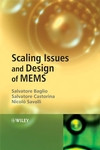

Most ebook files are in PDF format, so you can easily read them using various software such as Foxit Reader or directly on the Google Chrome browser.
Some ebook files are released by publishers in other formats such as .awz, .mobi, .epub, .fb2, etc. You may need to install specific software to read these formats on mobile/PC, such as Calibre.
Please read the tutorial at this link: https://ebookbell.com/faq
We offer FREE conversion to the popular formats you request; however, this may take some time. Therefore, right after payment, please email us, and we will try to provide the service as quickly as possible.
For some exceptional file formats or broken links (if any), please refrain from opening any disputes. Instead, email us first, and we will try to assist within a maximum of 6 hours.
EbookBell Team

4.3
78 reviewsWith an original approach, this informative text encompasses the entire range of themes currently at the forefront of MEMS, including an analysis of the importantissue of energy sources in MEMS. In addition, the book explores contemporary research into the design of complete MEMS with a case study on colonies of microbots.
Scaling Issues and Design of MEMS aims to improve the reader’s basic knowledge on modelling issues of complex micro devices, and to encourage new thinking about scaling effects. It will provide support for practising engineers working within the defence industry and will also be of welcome interest to graduate students and researchers with a background in electronic engineering, physics, chemistry, biology and materials science.Content:
Chapter 1 Scaling of MEMS (pages 1–17):
Chapter 2 Scaling of Microactuators – An Overview (pages 19–52):
Chapter 3 Scaling of Thermal Sensors (pages 53–72):
Chapter 4 Inductive Sensors for Magnetic Fields (pages 73–101):
Chapter 5 Scaling of Mechanical Sensors (pages 103–148):
Chapter 6 Scaling of Energy Sources (pages 149–168):
Chapter 7 Technologies and Architectures for Autonomous MEMS Microrobots (pages 169–178):
Chapter 8 Moving Towards the Nanoscale (pages 179–187):
Chapter 9 Examples of Scaling Effects Analysis – DIEES?MEMSLAB (pages 189–220):
Chapter 10 Concluding Remarks (pages 221–222):